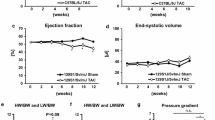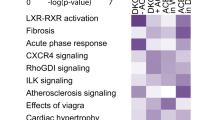Abstract
Background
Human acute coronary syndrome refers to the spectrum of clinical manifestations of overt coronary artery (CAD) disease characterized by atherosclerotic plaque destabilization and resultant myocardial injury. Typically studied as distinct pathologies, emerging pathogenic paradigms implicate multiple processes beyond thrombosis and ischemic cell injury respectively, with significant pathway overlap involving inflammation, apoptosis, matrix degradation, and oxidative stress. However, all these pathways have also been implicated in still-quiescent coronary plaque progression, thus making it harder to pinpoint the turnkey events leading to overt-CAD. Analysis of transcription profiles could identify a working framework of pathogenesis distinguishing overt-CAD.
Materials and Methods
We investigated the transcription profile associated with overt-coronary artery disease (CAD), in contrast to quiescent-CAD and attenuated, quiescent-CAD using the Tg53 transgenic atherosclerosis-hypertensive rat model, which exhibits end-stage coronary heart disease simulating human acute coronary syndromes. Using a rat-specific known-gene oligonucleotide array, twice corroborated transcription profiles from four individual Tg53 rats exhibiting overt-CAD were analyzed and contrasted to transcription profiles of age-matched Tg53 rats with quiescent-CAD (pooled n = 4) and attenuated, quiescent-CAD (pooled n = 4).
Results
Tg53 male rats with overt-CAD exhibited distinct transcription profiles compared with both quiescent-CAD control groups. Functional gene cluster analysis detects upregulation of genes involved in inflammation (interleukin-1, interleukin-18, FcγII receptor, thyrotropin releasing hormone), matrix balance (membrane type metalloproteinase, TIMP-1, lysyl oxidase), oxidized LDL entry (endothelial oxLDL receptor), which contrast deinduced gene clusters involved in angiogenesis, proliferation, metabolism, ion transport and adrenergic receptors.
Conclusions
The data demonstrate that transcriptionally mediated events distinguish the onset of overt-CAD and identify a first list of putative “turnkey” genes. This altered molecular framework implies an altered “hardwiring” which a priori would require multifaceted, targeted intervention-currently not implemented to date. Although more studies are necessary, early concordance with current pathogenic paradigms of human coronary plaque destabilization and post-ischemic myocardial response provides translational significance to observations and hypotheses.




Similar content being viewed by others
References
Libby P, Geng YJ, Sukhova GK, et al. (1997) Molecular determinants of atherosclerotic plaque vulnerability. Ann. N.Y. Acad. Sci. 811: 134–142.
Zhou J, Chew M, Ravn HB, Falk E. (1999) Plaque pathology and coronary thrombosis in the pathogenesis of acute coronary syndromes. Scan. J. Clin. Lab. Invest. 230: 3–11.
Delager-Pedersen S, Pederson EM, Ringgaard S, Falk E. (1999) In: Fuster V, (ed.) The Vulnerable Atherosclerotic Plaque. Futura, NY, pp. 1–23.
Frangogiannis NG, Smith CW, Entman ML. (2002) The inflammatory response in myocardial infarction. Cardiovasc. Res. 53: 31–47.
Virmani R, Kolodgie FD, Burke AP, et al. (2000) Lessons from sudden coronary death: a comprehensive morphological classification scheme for atherosclerotic lesions. Arterioscler. Thromb. Vasc. Biol. 20: 1262–1275.
Glagov S, Rowley DA, Kohut RI. (1961) Atherosclerosis of human aorta and its coronary and renal arteries. Arch. Pathol. 72: 82–95.
Herrera VLM, Makarides SC, Xie HX, et al. (1999) Spontaneous combined hyperlipidemia, coronary heart disease and decreased survival in Dahl salt-sensitive hypertensive rats transgenic for human cholesteryl ester transfer protein. Nat. Med. 5: 1383–1389.
Herrera VLM, Didishvili T, Lopez LV, et al. (2001) Hypertension exacerbates coronary artery disease in transgenic hyper-lipidemic Dahl salt-sensitive hypertensive rats. Mol. Med. 7: 831–844.
Lyn D, Liu X, Bennett NA, Emmett NL. (2000) Gene expression profile in mouse myocardium after ischemia. Physiol. Genomics 2: 93–100.
Gilles C, Polette M, Piette J, et al. (1996) High level of MT-MMP expression is associated with invasiveness of cervical cancer cells. Int. J. Cancer 65: 209–213.
Jin L, Yuan RQ, Fuchs A, et al. (1997) Expression of interleukin-1beta in human breast carcinoma. Cancer 80: 421–434.
Apte RN, Dvorkin T, Song X, et al. (2000) Opposing effects of IL-1 alpha and IL-1 beta on malignancy patterns. Tumor cell-associated IL-1 alpha potentiates anti-tumor immune responses and tumor regression, whereas IL-1 beta potentiates invasiveness. Adv. Exp. Med. Biol. 479: 277–288.
Belkin AM, Akimov SS, Zaritskaya LS. (2001) Matrix-dependent proteolysis of surface transglutaminase by membrane-type metalloproteinase regulates cancer cell adhesion and locomotion. J. Biol. Chem. 276: 18415–18422.
Yoshikawa T, Tsuburaya A, Kobayashi O, et al. (2001) Intratumoral concentrations of tissue inhibitor of matrix metalloproteinase 1 in patients with gastric carcinoma: a new biomarker for invasion and its impact on survival. Cancer 91: 1739–1744.
Kirschman DA, Seftor EA, Nieva DR, et al. (1999) Differentially expressed genes associated with the metastatic phenotype in breast cancer. Breast Cancer Res. Treat. 55: 127–136.
Lazarus HM, Cruikshank WW, Narashimhan N, et al. (1995) Induction of human monocyte motility by lysyl oxidase. Matrix Biol 14: 727–731.
Lee CK, Klopp RG, Weindruch R, Prolla TA. (1999) Gene expression profile of aging and its retardation by caloric restriction. Science 285: 1390–1394.
Fabunmi RP, Sukhova GK, Sugiyama S, Libby P. (1998) Expression of tissue inhibitor of metalloproteinases-3 in human atheroma and regulation in lesion-associated cells: a potential protective mechanism in plaque stability. Circ. Res. 83: 270–278.
Rouis M, Adamy C, Duverger N, et al. (1999) Adenovirus-mediated overexpression of tissue inhibitor of metalloproteinase-1 reduces atherosclerotic lesions in apolipoprotein E-deficient mice. Circulation 100: 533–540.
Noji Y, Kajinami K, Kawashiri MA, et al. (2001) Circulating matrix metalloproteinases and their inhibitors in premature coronary atherosclerosis. Clin. Chem. Lab. Med. 39: 380–384.
Coussens LM, Fingleton B, Matrisian LM. (2002). Matrix metalloproteinases inhibitors and cancer: trials and tribulations. Science 295: 2387–2392.
Csiszar K. (2001) Lysyl oxidases: a novel multifunctional amine oxidase family. Prog. Nucleic Acid Res. Mol. Biol. 70: 1–32.
Shi ZX, Xu W, Mergner WJ, et al. (1996) Localization of thyrotropin-releasing hormone mRNA expression in the rat heart by in situ hybridization histochemistry. Pathobiology 64: 314–319.
Perez Castro C, Penalva R, Paez Pereda M, et al. (1999) Early activation of thyrotropin-releasing-hormone and prolactin plays a critical role during a T cell-dependent immune response. Endocrinology 140: 690–697.
Koshida H, Kotake Y. (1993) Thyrotropin-releasing hormone enhances the superoxide anion production of rabbit peritoneal macrophages stimulated with N-formyl-methionyl-leucyl-phenylalanine and opsonized zymosan. Life Sci. 53: 725–731.
Ratcliffe NR, Kennedy SM, Morganelli PM. (2001) Immunocytochemical detection of Fc-gamma receptors in human atherosclerotic lesions. Immunol. Let. 77: 169–174.
Zebrack JS, Anderson JL, Maycock CA, et al. (2002) Usefulness of high-sensitivity C-reactive protein in predicting long-term risk of death or acute myocardial infarction in patients with unstable or stable angina pectoris or acute myocardial infarction. Am. J. Cardiol. 89: 145–149.
Chi M, Tridandapani S, Zhong W, et al. (2002) C-reactive protein induces signaling through Fc-gamma RIIa on HL-60 granulocytes. J. Immunol. 168: 1413–1418.
Dinarello CA. (1999) Interleukin-18. Methods 19: 121–132.
Grutkoski PS, D’Amico R, Ayala A, Simms HH. (1999) Il-1 beta stimulation induces paracrine regulation of PMN function and apoptosis. Shock 12: 373–381.
Leung BP, Culshaw S, Gracie JA, et al. (2001) A role for IL-18 in neutrophil activation. J. Immunol. 167: 2879–2886.
Ogura T, Ueda H, Hosohara K, et al. (2001) Interleukin-18 stimulates hematopoietic cytokine and growth factor formation and augments circulating granulocytes in mice. Blood 98: 2101–2107.
Mallat Z, Corbaz A, Scoazec A, et al. (2001) Expression of interleukin-18 in human atherosclerotic plaques and relation to plaque instability. Circulation 104: 1598–1603.
Pomerantz BJ, Reznikov LL, Harken AH, Dinarello CA. (2002) Inhibition of caspase 1 reduces human myocardial ischemic dysfunction via inhibition of IL-18 and IL-1β. Proc. Natl. Acad. Sci. 98: 2871–2876.
Feng Y, Yang JH, Huang H, et al. (1999) Transcriptional profile of mechanically induced genes in human vascular smooth muscle cells. Circ. Res. 85: 1118–1123.
Acknowledgments
We acknowledge excellent technical assistance of Kimberly Zander and Sarah T. Cruz. This work was supported in part by a grant from the NIH National Heart, Lung, and Blood Institute (HL 62857) and by a grant-in-aid from the American Heart Association.
Author information
Authors and Affiliations
Corresponding author
Rights and permissions
About this article
Cite this article
Herrera, V.L.M., Didishvili, T., Lopez, L.V. et al. Differential Regulation of Functional Gene Clusters in Overt Coronary Artery Disease in a Transgenic Atherosclerosis-hypertensive Rat Rodel. Mol Med 8, 367–375 (2002). https://doi.org/10.1007/BF03402017
Accepted:
Published:
Issue Date:
DOI: https://doi.org/10.1007/BF03402017




